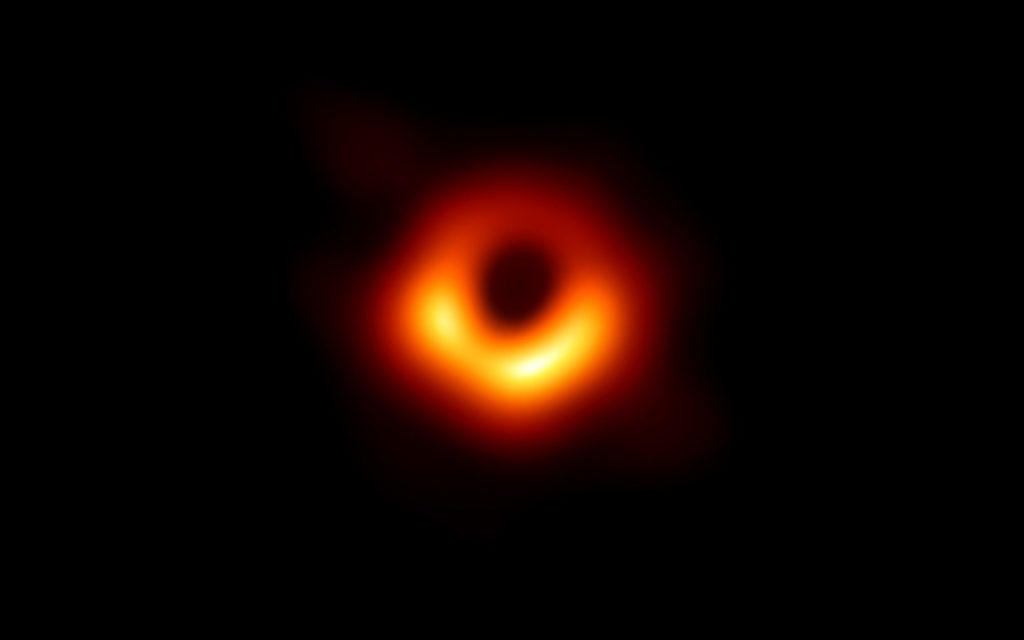For the second time, astronomers have obtained the image of a black hole; this time, the one at the centre of our own galaxy. Notwithstanding claims to the contrary, this shows that not everything is perceived through vision.
HUSAM AHMED SHAFEEQ
MAY 29, 2022
Seeing is believing. The convincing power of sight is so strong that it can cement any idea – however unusual or unlikely – into our perceptions with utmost firmness and certitude.
This influential power of our sense of vision was experienced worldwide this month when scientists at the Event Horizon Telescope program released an image of a supermassive black hole, Sagittarius A*, situated at the centre of our galaxy, the Milky Way. Earlier, in 2019, the same project had released the image of another black hole located in the M87 galaxy, making it the first image of any black hole ever captured by man.
The idea of black holes – regions in spacetime with extremely strong gravity that not even light can escape – and its journey from speculation to reality is truly astonishing. Quite incredibly, these dark objects shed ample light on how we should tread the path of investigation and undertake the intellectual journey towards truth.
The theory in the making
Though the existence of massive stars with strong gravity preventing even light from escaping was proposed by John Michell in the late 1700s, the notion was discredited for its failure to explain why light, given its wavelike nature, would be affected by gravity.[1]
A more accurate explanation of the concept only became possible on the basis of Einstein’s general theory of relativity, which explained gravity not as a force between two bodies, but as a curvature in the fabric of spacetime that would cause any body passing through that region of space to be affected; light being no exception. It was proposed, therefore, that a sufficiently dense and compact mass can deform spacetime to form black holes.[2]
Initially, physicists were largely sceptical that such mysterious objects could really exist. It took immense efforts of great scientists to develop a tenable theoretical framework for their existence and kick-start this new voyage of knowledge. As a result, the scepticism gradually started to dampen as the topic attracted more and more minds to research on it.
Up until this point, physicists had worked on the concept only on theoretical grounds. However, their seminal contributions would later provide a strong impetus for future endeavours in this direction and open up new avenues of investigation.
Finding the footprints
Once the theory was fully developed like an embryo inside an egg, it only had to wait for the right moment to hatch.
Hence the time approached, in 1964, when strong x-ray emissions were detected by a rocket launched from White Sands Missile Range in New Mexico. The radiation was originating from an accretion disc of stellar matter formed around a massive hidden object, dubbed Cygnus X-1, which was surmised to be a black hole. The hypothesis was supported by further findings making it the first galactic x-ray source to be considered a black hole[3]. Although there is no direct evidence proving Cygnus to be a black hole, it has been widely accepted as one for being the best explanation of the observed phenomenon.
Another observational evidence for the existence of black holes was found in the mid-1990s when scientists started studying the motion of ninety stars at the centre of the Milky Way Galaxy. These stars appeared to be orbiting an invisible object. After a long and careful study, scientists were able to infer the strong possibility – from indirect evidence – that the orbited body was a supermassive black hole.[4]
A breakthrough in this quest for evidence was achieved when the LIGO observatory successfully detected gravitational waves emanating from the merging of two black holes[5]. This was a remarkable accomplishment that set a milestone in our knowledge about these exotic objects. Detecting gravitational waves from black holes was tantamount to finding the footprints of an animal, theorized to exist, with the exact predicted features.
By now, black holes had travelled far past the line of being mere theoretical entities and the chance of doubting their existence had diminished to a great extent. But that was not the end of the story.
Seeing the unseeable
It is one thing to infer the presence of an object from its effects. It is totally another to directly observe the concerned object. The past observations related to black holes have either been inferential or detecting their effects, while conclusive evidence for their existence was yet to be found.
Here comes in the Event Horizon Telescope – a global network of telescopes working to observe radio sources associated with black holes. In April 2017, scientists at the EHT project started observing a black hole situated at the centre of the M87 galaxy. After collecting data for around ten days, and then processing them for a further two years, in April 2019, they released the first-ever image of a black hole to a world struck with awe.[6]
The blurry image only showed a faintly glowing shape that resembled a doughnut, yet was powerful enough to captivate anyone who laid eyes on it. Not long after, on 12 May 2022, the project released the image of another black hole, named Sagittarius A*, ushering in a new era of our understanding of these incredible things[7].
The influential power of seeing hence worked its magic and the concept that was once unbelievable got transformed into undeniable. Does this not present a strong case for the role sight plays in shaping our perceptions? Or does this, on the contrary, reiterate the fact that everything is not perceived through vision alone?
The sight of insight
The universe offers amazing spectacles for man to behold. But a staggering majority of those wonders are indecipherable to our eyes – black holes being one among them.
To imagine a thing more invisible than black holes is almost a futile act. The very definition of these peculiar objects casts them completely outside the realm of the visible. Anything, including light, that trespasses the threshold known as the event horizon would be devoured by the gravity of these things, rendering them unseeable.
This may perplex any curious mind with respect to the content of the now-famous images. It should be remembered that the images do not show black holes as such. Instead, what we see is the accretion disc orbiting the black hole at a safe distance from the event horizon. The matter comprising the disc emits electromagnetic radiation. The gravity bends those waves resulting in a shadow being imprinted on that radiation pattern. This shadow is what we see as the dark spot in the middle[8]. By observing the disc, we can calculate the exact radius of the black hole in the centre and accurately visualize its form in our minds.
Suffice it to say, although our eyes do not see the black hole, our intellect concludes its presence, with absolute certainty, by observing the effects it produces on the surrounding matter. Hence, the story of black holes provides strong testimony to the fact that a thing, though hidden in one sense, can yet be ‘seen’ through the agency of other faculties.
This principle, however, is not confined to the case of black holes. Rather, there are myriads of entities that are imperceptible to our eyes or any of our physical senses. They are even beyond the reaches of all the sophisticated instruments man has ever built to widen the spectrum of his sensory perception. Yet, we believe that those things exist. We assert that to deny their existence amounts to the highest degree of stupidity. Nonetheless, for some people, this rule carries an exception.
An obstinate demand to perceive God through the medium of our physical faculties forms the logical basis of atheism – a worldview followed by millions. Although the age-old argument that God’s invisibility implies His non-existence is discarded as untenable in this age, bringing God to the domain of physics still remains the stubborn demand of many atheists even today.
As strange as it may appear, this flawed case is valiantly presented as an impeccable argument against God, whose signature is evidently visible in everything that exists – from the specifically complex arrangement of the nucleotides in our DNA to the mesmerizing precision in the fundamental values and laws that govern the whole universe.
REFERENCES
[1] Michell, Laplace and the Origin of the Black Hole Concept by Colin Montgomery, Journal of Astronomical History and Heritage January 2009
[2] Gravitational Collapse and Cosmic Censorship by Robert M Wald, Black Holes Gravitational Radiation and the Universe p. 69
[3] The Implausible History of Triple Star Models for Cygnus X-1: Evidence for a Black Hole by H L Shipman, Astrophysical Letters v. 16, pp. 9-12
[4] High Proper-Motion Stars in the Vicinity of Sagittarius A*: Evidence for a Supermassive Black Hole at the Center of Our Galaxy by A M Ghez, The Astrophysical Journal 20 December 1998
[5] Observation of Gravitational Waves from a Binary Black Hole Merger by B P Abbott, Physical Review Letters 12 February 2016
[6] The First Picture of a Black Hole Opens a New Era of Astrophysics by Lisa Grossman and Emily Conover, Science News 10 April 2019
[7] The Milky Way’s Black Hole Comes to Light by Dennis Overbye, The New York Times 12 May 2022
[8] First M87 Event Horizon Telescope Results. I. The Shadow of the Supermassive Black Hole by the Event Horizon Telescope Collaboration, The Astrophysical Journal Letters 10 April 2019













3 Comments
Naseer Ahmad CG · May 29, 2022 at 6:02 am
MashaAllah.
Honestly saying, I do not have enough knowledge about this subject, but the conclusion that you made from is very brilliant and may Allah help everyone to understand, believe and worship our creator in right sense.
K N Mohammad Shafeeque · May 30, 2022 at 3:29 am
The author of the article fully justified its title in light of latest scientific developments and exposed the illogical element of atheists’ demand of perceiving God through the medium of vision or any physical faculty.
Sulthan Ahmed · May 31, 2022 at 7:32 am
Masha Allah 👍🏼👍🏼
Articles like these, Need of the time